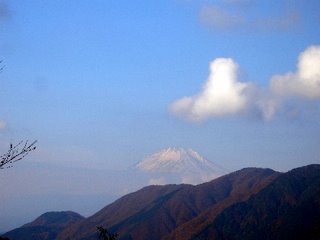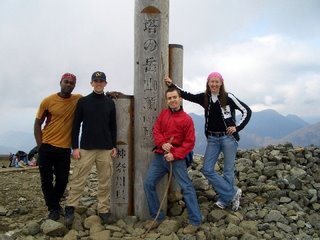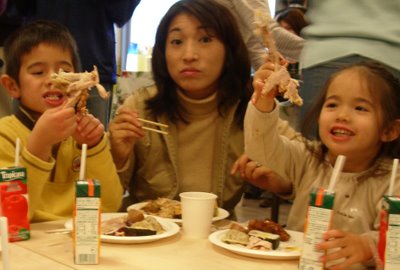I've heard several Japanese say that their country is unique in having four seasons. I don't know where the idea comes from that other countries have fewer seasons, but I do notice a lot of seasonal celebrations and observances here. My father-in-law took this picture today near the Uji River in Kyoto.
November 28, 2006
November 26, 2006
What?
My son has said some crazy mixed-up stuff lately.
"Yeah, Murdoch the red-nosed reindeer."
"Dad, there are more chimpanzees outside this morning."
(Looking out) "I don't see any chimpanzees."
"In the pot right there."
"Oh, you mean pansies!"
"Yeah--chimpanzees."
(After reading a Bible story about John baptizing Jesus) "Dad, he was Jesus' cousin, right?"
"Wow, you remembered that?"
"Yeah, and his Mom is Emily Elizabeth."
(Emily Elizabeth is the girl in the "Clifford" stories.)
"Why didn't anybody like Murdoch?"
"Murdoch?""Yeah, Murdoch the red-nosed reindeer."
"Dad, there are more chimpanzees outside this morning."
(Looking out) "I don't see any chimpanzees."
"In the pot right there."
"Oh, you mean pansies!"
"Yeah--chimpanzees."
(After reading a Bible story about John baptizing Jesus) "Dad, he was Jesus' cousin, right?"
"Wow, you remembered that?"
"Yeah, and his Mom is Emily Elizabeth."
(Emily Elizabeth is the girl in the "Clifford" stories.)
November 23, 2006
Happy Thanksgiving
Turkey, gravy, mashed potatoes, cranberry sauce, sweet potatoes, sushi, and goya. Sushi and goya?! Yes, we celebrated another Thanksgiving in Japan. Here is the spread:
We celebrated at our preschool / church / community life center. About ninety people showed up for the festivities, many from the church but also several preschool students and their families. An American guy explained the historical roots of the holiday, we feasted on turkey (and less traditional things), played some silly games, talked about what we're thankful for, and called it a day. What I'm thankful for, now more than ever, is my wonderful family. Here they are:
We celebrated at our preschool / church / community life center. About ninety people showed up for the festivities, many from the church but also several preschool students and their families. An American guy explained the historical roots of the holiday, we feasted on turkey (and less traditional things), played some silly games, talked about what we're thankful for, and called it a day. What I'm thankful for, now more than ever, is my wonderful family. Here they are:
November 20, 2006
Christianity in Japan
This news had been out for a while but I read about it again today in Andy's brushed blog. Contrary to the one-percent figure that has been thrown about for years, four percent of Japanese claim to be Christians according to a recent Gallup poll. (Note the correction from six to four percent.) These numbers are in line with what I would guess from my own experience (the church I attend has gone from 15 to over 300 weekly attendees in six years) and with anecdotal evidence I've heard. A web search will uncover many perspectives on the poll's findings. I'll just share briefly what jumped out at me from Gallup's comments on the poll.
"[H]alf of teens say they do not know enough about the teachings of Jesus in order to give an evaluation." Yet, of the two in ten teenagers who claim they have a religion, one-third describe themselves as Christians. This means that about seven percent of Japanese teenagers call themselves Christians! It also leads me to think that if more young people knew the teachings of Jesus, the teenage Christian population would pass ten percent. Gallup says, "Clearly, all-out efforts should be made to increase the awareness and knowledge of Christianity and the teachings of Jesus Christ---through schools . . ." I'm excited to be part of telling young people about the teachings of Jesus. What they choose to do with these teachings is up to them, but I'm glad that my students won't be among those who don't have a basis for evaluation.
"[H]alf of teens say they do not know enough about the teachings of Jesus in order to give an evaluation." Yet, of the two in ten teenagers who claim they have a religion, one-third describe themselves as Christians. This means that about seven percent of Japanese teenagers call themselves Christians! It also leads me to think that if more young people knew the teachings of Jesus, the teenage Christian population would pass ten percent. Gallup says, "Clearly, all-out efforts should be made to increase the awareness and knowledge of Christianity and the teachings of Jesus Christ---through schools . . ." I'm excited to be part of telling young people about the teachings of Jesus. What they choose to do with these teachings is up to them, but I'm glad that my students won't be among those who don't have a basis for evaluation.
November 19, 2006
Hike Japan
Yesterday I went hiking in the Tanzawa area with a few friends. I love getting some space, fresh air and open vistas. Going to the mountains once in a while is how I stay sane in Tokyo. They aren't far away, and a lot of nice places are easily accessible by train or bus. Here are a few pictures.

fall foliage

Mount Fuji in the distance

top of Tonodake

fall foliage

Mount Fuji in the distance

top of Tonodake
If you're interested in hiking Japan, there's much to read on the internet, or you can check out these books on amazon.com . They're also available in a lot of libraries.
. They're also available in a lot of libraries.
November 17, 2006
Without It, I Am Nothing
I like to make the most of my reading time on the train; I usually don't close my book until I step out onto the platform, and sometimes not even then. But a passage struck me so hard this morning that I had to close my book a couple stops before my station and just let it sink in. From Jerry Bridges book, Crisis of Caring
book, Crisis of Caring :
:
Of course the basis of these words is here. However innovative, productive, diligent, gifted, charismatic, and "successful" we are, without love we are nothing but zeros, a long row of zeros maybe, but zeros nonetheless.
Write down, either in your imagination or on a sheet of paper, a row of zeros. Keep adding zeros until you have filled a whole line on the page. What do they add up to? Exactly nothing! Even if you were to write a thousand of them, they would still be nothing. But put a positive number in front of them and immediately they have value. This is the way it is with our gifts and faith and zeal. They are zeros on the page. Without love, they count for nothing. [. . .] And just as the number two gives more value to a row of zeros than the number one does, so more and more love can add exponentially greater value to our gifts.
Of course the basis of these words is here. However innovative, productive, diligent, gifted, charismatic, and "successful" we are, without love we are nothing but zeros, a long row of zeros maybe, but zeros nonetheless.
November 15, 2006
Hair Dryer vs. Common Cold
The cold season is upon us and I've noticed a new remedy (new to me anyway) floating around on the internet. In addition to the usual ways to keep the immune system strong (healthy diet, plenty of sleep, exercise, water and hand-washing), some people swear by blowing a hair dryer up your nose.
According to this post on Ask Metafilter:
The hair dryer trick works on a number of levels. First, rhino virus (one of the virus families that causes about 35% of common colds in adults) grows best at temperatures around 91° F, and dies above 105° F. So, raising the temperature of your nose, and nasal and sinuses to 104° F for a few minutes can kill a lot of virus. Second, warming your nasal membranes and sinuses this way immediately dries them, and can shrink them, relieving headache pain and pressure. Drying the nose and sinuses temporarily also inhibits the growth of virus, and transmission of virus through nasal drip, tissues, and sneezing. Third, drying the nose and sinuses interrupts the natural histamine reactions that cause tissue swelling and sensitize you to other allergens.
Use a bit of lotion on your nose and face to keep from drying the skin unduly, set the hair dryer on low heat, low airflow settings (or higher, if you can take it), and breathe warm, dry air for 3 to 5 minutes at time, or until you can feel your nose and face are thoroughly warmed and dried. You can repeat as often as needed, but doing this 4 to 6 times in the first 24 hours of feeling drippy or stuffy will reliably stop a cold in its tracks, and will provide substantial symptomatic relief of on-going colds in later stages.
Your mileage may vary--after all, the writer goes on to extol the cold-fighting virtues of Scotch whiskey and buttered toast with marmalade. A slightly more authoritative source for the hair dryer cure is here.
I'm not planning to catch a cold, but if I do, I think I'll try this. How about you? What's your favorite home remedy?
Edit 12/21/2010: For some reason, this post has received a surprising amount of traffic. I researched the topic a little more and wrote a similar but better researched article on the hair dryer cure for the common cold.
November 14, 2006
Run-In with the Law
I like climbing things: mountains, rocks, walls, trees, whatever. Today we took the preschool children on an outing to a big park near the school. We climbed some "novice level" trees together. At one point when the children were busy with something else and other teachers were watching them, a bigger tree beckoned and I excused myself to climb. I climbed and must have lost myself in the experience because when I came down and jumped the last six or eight feet to the ground, I landed right at the feet of two police officers. Evidently, they hadn't seen me in the tree because one of them yelled out "Bikkurishita" which translates to "I was surprised" but really means something more like AAAAAHHH!!! This could have been a mess because police in Japan are occasionally known to hassle foreigners and I had definitely given them an excuse.They asked me what I was doing.
"Climbing."
"Climbing trees?"
"Yes. Just climbing trees."
"Hmmmm . . . OK. Good bye.
"Good bye. Thank you. (sigh of relief)"
"Climbing."
"Climbing trees?"
"Yes. Just climbing trees."
"Hmmmm . . . OK. Good bye.
"Good bye. Thank you. (sigh of relief)"
November 12, 2006
Softbank Mobile: Really a Good Deal?
Last month, number portability came into effect in Japan. Customers can now switch mobile providers and keep their phone numbers. Softbank Mobile (formerly Vodafone Japan) made big news with a new flat-rate plan and a promise always to undercut the other two big providers by 200 yen per month.
Frugal guy that I am, I've been researching the different providers for the best deal. Japanese bloggers have written a lot about the different providers' plans, but there isn't much out there in English. I'm by no means an expert, but I'll share what I've learned.
Softbank's flat-rate plan (Gold Plan) has a basic monthly rate of 2880 yen and advertises free email and free calls to other Softbank subscribers. There are a few catches though (aren't there always).
* There is no monthly call allowance to phones other than Softbank. The first minute of the first call to a fixed line or another mobile phone company is charged in addition to the basic monthly fee.
* Softbank to Softbank calls are not free if calls exceed 200 minutes per month between 9PM and 1AM. That's about six minutes per day during those hours.
* Subscribers to the Gold Plan must sign a two-year contract called "New Super Bonus." This "Bonus" basically means Softbank subsidizes the cost of the phone. A subscriber who doesn't fulfill the whole two years has to pay whatever is left on the price of the phone. (Most phones are tens of thousands of yen.)
This plan is good for people who mostly talk to other Softbank subscribers in the off-peak times and don't mind a two-year commitment.
I spent some time in the Softbank shop the other day and after asking a lot of questions, found that the Orange Plan and Blue Plan are the same as plans offered by Au and Docomo respectively, but 200 yen cheaper. Au has two 3G systems with two price plans so Softbank also has the two price plans even though they only have one 3G system. The Softbank associate recommended the "Orange Plan W" and mysteriously kept his hand over the "Orange Plan X" page of the brochure. Surprise! The "X" plan is less expensive.
I've been a Softbank user since the J-Phone days and have over four years in the system. Rather than swtiching to another company, I'll probably go with the Orange Plan (X) Economy package. I'll wait another month or so and see if Docomo or Au run an enticing campaign and then finally upgrade my antique phone.
In a nutshell, I learned that there isn't much point in changing carriers. Unless your calling patterns fit the profile of the ideal Softbank Gold Plan user, price differences aren't that big. Especially considering the issues of network coverage, and changing email addresses, if you are happy with your current service, just keep it.
If you're interested in comparing, here are Softbank's, Au's, and Docomo's price plans. Be aware that the price of the handsets and each carrier's various discounts can greatly change the final price you pay.
Edit 11/24/2006: If you are interested in changing providers and are having some trouble with the process, please see this post at tsukublog for an excellent English explanation.
Related Posts:
Frugal guy that I am, I've been researching the different providers for the best deal. Japanese bloggers have written a lot about the different providers' plans, but there isn't much out there in English. I'm by no means an expert, but I'll share what I've learned.
Softbank's flat-rate plan (Gold Plan) has a basic monthly rate of 2880 yen and advertises free email and free calls to other Softbank subscribers. There are a few catches though (aren't there always).
* There is no monthly call allowance to phones other than Softbank. The first minute of the first call to a fixed line or another mobile phone company is charged in addition to the basic monthly fee.
* Softbank to Softbank calls are not free if calls exceed 200 minutes per month between 9PM and 1AM. That's about six minutes per day during those hours.
* Subscribers to the Gold Plan must sign a two-year contract called "New Super Bonus." This "Bonus" basically means Softbank subsidizes the cost of the phone. A subscriber who doesn't fulfill the whole two years has to pay whatever is left on the price of the phone. (Most phones are tens of thousands of yen.)
This plan is good for people who mostly talk to other Softbank subscribers in the off-peak times and don't mind a two-year commitment.
I spent some time in the Softbank shop the other day and after asking a lot of questions, found that the Orange Plan and Blue Plan are the same as plans offered by Au and Docomo respectively, but 200 yen cheaper. Au has two 3G systems with two price plans so Softbank also has the two price plans even though they only have one 3G system. The Softbank associate recommended the "Orange Plan W" and mysteriously kept his hand over the "Orange Plan X" page of the brochure. Surprise! The "X" plan is less expensive.
I've been a Softbank user since the J-Phone days and have over four years in the system. Rather than swtiching to another company, I'll probably go with the Orange Plan (X) Economy package. I'll wait another month or so and see if Docomo or Au run an enticing campaign and then finally upgrade my antique phone.
In a nutshell, I learned that there isn't much point in changing carriers. Unless your calling patterns fit the profile of the ideal Softbank Gold Plan user, price differences aren't that big. Especially considering the issues of network coverage, and changing email addresses, if you are happy with your current service, just keep it.
If you're interested in comparing, here are Softbank's, Au's, and Docomo's price plans. Be aware that the price of the handsets and each carrier's various discounts can greatly change the final price you pay.
Edit 11/24/2006: If you are interested in changing providers and are having some trouble with the process, please see this post at tsukublog for an excellent English explanation.
Related Posts:
November 11, 2006
Learning to Like Natto
After living in Japan for almost nine years, I decided to grow up and acquire a taste for the stuff by sheer force of willpower. It's said to be very healthy and I enjoy other fermented foods like yogurt and cheese. Last week I ate some with rice and nori (dry seaweed). This evening I ate two servings. I was able to swallow it without gagging or needing to wash it down right away. I don't plan to start ordering it in restaurants or anything, but I'm happy to say that pretty soon when I'm asked the inevitable "You're a foreigner so you can't eat natto, can you?" I'll be able to answer, "Yes, as a matter of fact I can."
[Photo Credit: ...natto... by roboppy]
Airborne!
In Japan, the land of complicated garbage, you can't just throw umbrellas away when they get broken; you have to separate the fabric from the frame and throw the pieces away separately. While cutting an umbrella apart with T, one of us had the idea to make a parachute. We quickly assembled one with some string, harnessed Green Lantern into it and . . . you see the result. It worked really well. This shot is of the parachute flying from the top bunk. We also dropped it from the fourth floor of our apartment stairwell a few times, but what with the rain and all, I couldn't get a good photo. Great fun!
November 6, 2006
"Go to the Ant"
The whole Achieve-It article is worth reading. The author took seriously King Solomon's words from a few thousand years ago and considered the ways of the ant.
- Ants follow proven instruction.
- Ants are determined.
- Ants see defeat as only temporary.
- Ants collaborate better than Wall Street executives.
- Ants defend what they have and expand it.
- Ants never let personalities get in the way.
- Ants never spend their whole paycheck.
- Ants expect more from themselves than should be possible.
- Ants remain focused until they succeed.
- Ants never give up.
November 3, 2006
Ueno Zoo
Yesterday was a holiday. The weather was great. A perfect day for the zoo. We weren't the only ones who thought so. Maybe I've lived in Japan too long, but the crowds didn't really bother me. I'd always rather spend more time with fewer animals than fighting crowds.
The zoo brought out the poetic in T and R. Watching a large bird T said, ""It's flapping its wings like . . . like thunder and lightning!" And R, holding a fluffy chicken in the petting zoo, said, "It feels like I'm holding a cloud."
I posted some other zoo photos with descriptions on flickr. Ueno Zoo is easily accessible by train or subway. It's open every day except Monday. Tickets are 600 yen for 15 years and up, 200 yen for junior high students, and free for elementary school students and younger. Admission is free on the zoo's anniversary (March 20), Greenery Day (April 29) and Tokyo Citizens' Day (October 1). Group discounts and senior discounts are available. More information is available in English here.
The zoo brought out the poetic in T and R. Watching a large bird T said, ""It's flapping its wings like . . . like thunder and lightning!" And R, holding a fluffy chicken in the petting zoo, said, "It feels like I'm holding a cloud."
I posted some other zoo photos with descriptions on flickr. Ueno Zoo is easily accessible by train or subway. It's open every day except Monday. Tickets are 600 yen for 15 years and up, 200 yen for junior high students, and free for elementary school students and younger. Admission is free on the zoo's anniversary (March 20), Greenery Day (April 29) and Tokyo Citizens' Day (October 1). Group discounts and senior discounts are available. More information is available in English here.
Subscribe to:
Posts (Atom)







